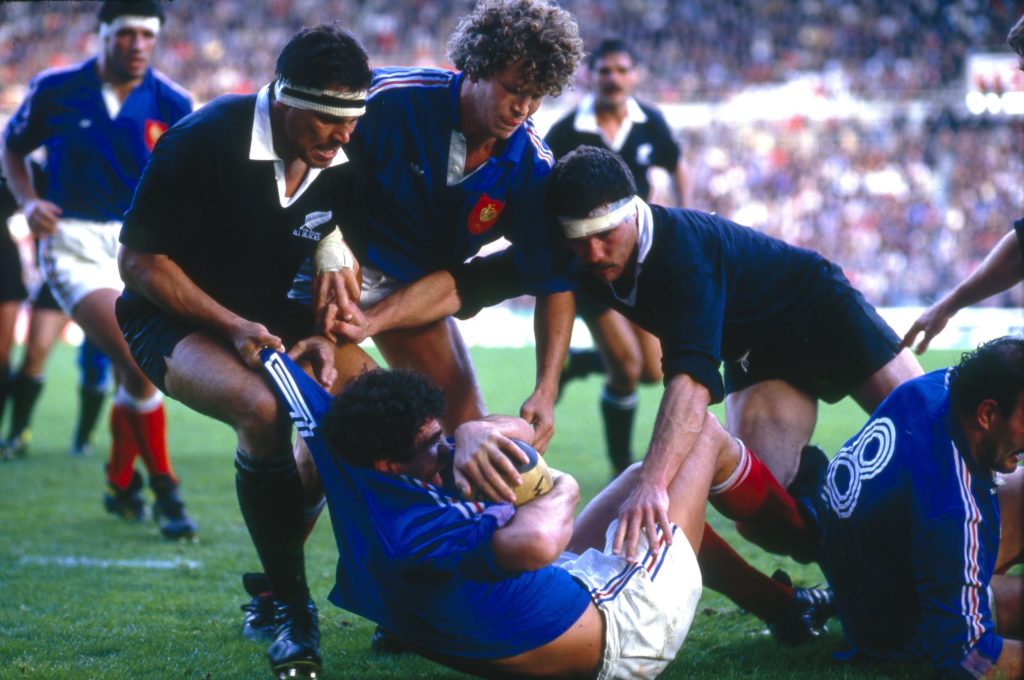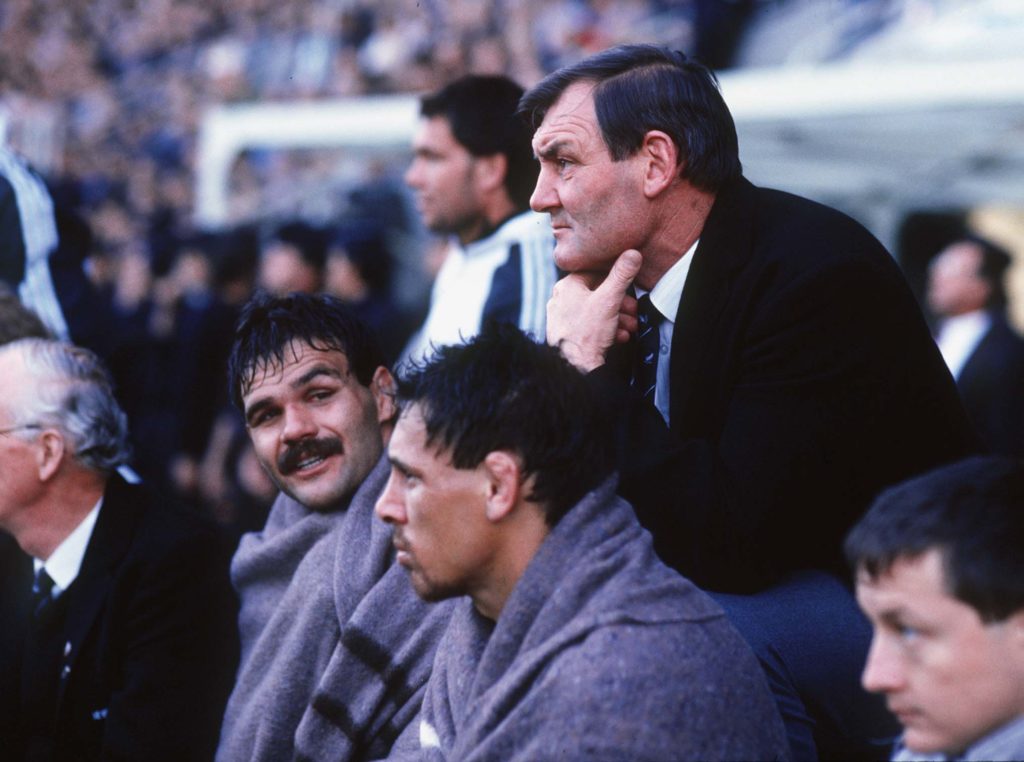When someone in the future sets out to sum up sayings that capture the essence of New Zealand one contribution from rugby is certain to stand out.
It was added to the lexicon 30 years ago, and still makes the odd appearance, whether on a long-forgotten rusting roadside sign, on a farmer’s billboard or after an especially frustrating All Blacks’ test loss, ‘Bring Back Buck’.
It’s synonymous with recalling the hard edge to performance, or as radio commentator Winston McCarthy famously once said, getting ‘a bit of mongrel in the pack’.
‘Buck’, of course, was Wayne Shelford, an inspirational figure on the back of the All Blacks’ scrum from 1986 until 1990 during which time he played 22 tests and appeared in 48 games.
He was captain in 14 of those tests – a period in which the All Blacks never lost and yet despite being universally recognised as the driving force behind one of the great, unbeaten teams in history, he was suddenly dropped in 1990.
It was one of the most contentious decisions in modern All Blacks history and one, even 30 years on, that generates intrigue and debate among New Zealand’s rugby fraternity.
It was one of the most contentious decisions in modern All Blacks history and one, even 30 years on, that generates intrigue and debate among New Zealand’s rugby fraternity
The story of Buck has been one of the most enduring and on the 30th anniversary of the decision to oust him as No 8 and captain, Shelford remains a larger than life, much-loved, iconic figure in New Zealand.
The legend of Buck has only grown and striking him down the way the All Blacks selectors of 1990 did, made him rugby’s version of Obi Wan Kenobi in that it made him stronger, more powerful than anyone could have imagined.
Shelford had a lengthy wait for test status, not making his All Blacks debut until he was aged nearly 29. Barring his way to an earlier cap was the formidable presence of Wellington’s Murray Mexted, who had made the position his own since 1979.
Shelford had played in Auckland sides but threw in his lot with North Harbour when it became New Zealand’s newest rugby province in 1985. As a new union, it had to work its way through second division rugby before claiming a first division place.

Shelford’s reputation was enhanced as he enjoyed consistent game time while leading the new team through the grades.
He was first selected for the All Blacks for the tour of South Africa in 1985 but when that was cancelled, as the result of legal action, he played on the hastily arranged tour of Argentina.
He joined the Cavaliers on their rebel tour to South Africa in 1986, where he was offered the chance to stay and play. But he turned it down when the incumbent Mexted told him he intended to retire after the tour.
Shelford was named No 8 for the third test against Australia, but a broken hand forced him to withdraw from the game, thereby missing the ignominy of being in a side that lost the Bledisloe Cup.
He was so severely assaulted in the Battle of Nantes in France that 18 stitches were required for his lacerated scrotum, all while suffering concussion.
However, he had recovered by the time the All Blacks set out for France on their end of year tour where his test debut came in a 19-7 win at Toulouse, Shelford getting a good start to creating the aura that developed around him by scoring the All Blacks only try in the win.
But the hard man approach that became associated with his play was firmly established in the Kiwi psyche when he was so severely assaulted in the Battle of Nantes in France that 18 stitches were required for his lacerated scrotum, all while suffering concussion.
The French have always understood the players who stand in their way of victory.
He was a hard-charging forward who led by example, and it also helped that he, and team-mate Hika Reid, had repurposed the All Blacks’ haka to give it more meaning and mana, something New Zealanders also appreciated.

As a No 8, he dominated the position as the All Blacks went on an unbeaten international romp from the start of the inaugural Rugby World Cup in New Zealand and Australia until he was dropped after the second test against Scotland in 1990.
It was not the longest of international careers, especially when compared to the much busier test calendar now. But it was one of the more successful.
After the Bledisloe Cup was regained at Sydney’s Concord Oval, following the Rugby World Cup, David Kirk retired as did the man he replaced as All Blacks captain Andy Dalton.
Shelford assumed the mantle of captain, firstly on a short tour of Japan, but then was confirmed as captain for a home series against Wales by the incoming coach Alex Wyllie.
He would never lose a test as captain, the closest he came was in the 19-19 second test draw at Ballymore in Brisbane in 1988.
The Welsh were humbled 52-3 and 54-9. So powerful was Shelford’s take-it-to-them leadership example that his place was well and truly established.
He later told television commentator Keith Quinn in his documentary series Legends of the All Blacks that he took on the job of captain, just like he would when given a job in the military. Take it on his broad shoulders and get on with it.
He would never lose a test as captain, the closest he came was in the 19-19 second test draw at Ballymore in Brisbane in 1988.
So when the All Blacks struggled in their second test against Scotland at Eden Park in 1990, winning 21-18 after a late Grant Fox penalty goal, although out-scored two tries to one by the tourists, reasons for the decline were sought.
Later in his autobiography Grizz the Legend, penned by Phil Gifford, Wyllie compared the All Blacks to ‘playing like a car with a chip in its gearbox.’
Something wasn’t right and in-depth studies he made of the two tests highlighted a problem in the loose forwards where there was a breakdown in support play.

Invariably openside flanker Mike Brewer was getting to breakdowns out wide first, with blindside flanker Alan Whetton more often second ahead of Shelford. Compounding that issue was a lack of cohesion between the loose forwards and the backline.
That had been one of the strong points of Shelford’s game, he continually provided drive from the back of the scrum, but the intensity in his effort had declined.
Wyllie felt the problem needed to be sorted because they wanted to play a certain way and needed to ensure the required impetus was available. Failing that a different approach would have to be applied.
In the background at this stage was the emerging figure of Zinzan Brooke, the loose forward apprentice who had been part of the World Cup side but who had taken time to step up to test class.
With Auckland dominant in provincial rugby, Brooke’s exposure on the back of a dominant scrum was rising all the time.
After the Scotland series, and ahead of a North Harbour NPC game against Northland, word was passed from Wyllie, through Harbour coach Peter Thorburn, that Shelford needed to perform well.
Selectors John Hart and Lane Penn went to Whangarei to watch second five-eighths Walter Little. Wyllie had gone to Hamilton to watch Australia’s tour game against Waikato.
When they met at Auckland Airport after their respective games Penn had said that Shelford had an average game.
Looking back 30 years after, Wyllie said: “There was a panel, three selectors and that was the way we saw it. Obviously, there was the likes of North Harbour, and you can’t blame them, who were upset over it, and it was a shame the way it did fall into place.”
He acknowledged it was a difficult decision to make because Shelford had been one of the key players since 1987 and had consistently fired.
However, it was never easy dropping players and he said he would have preferred not to have to drop him.
“Buck’s got that about him, a hell of a good guy,” he said.
There were supposed to have been punch-ups, and clandestine meetings of players wanting to remove Shelford.
After the decision, the rumour mill went into overdrive. Talkback radio was a relatively new feature of the sporting spectrum and it provided a hotbed of comment and rumour.
There were supposed to have been punch-ups, and clandestine meetings of players wanting to remove Shelford.
Wyllie said: “It doesn’t matter what happens there’s always rumours. It’s not a nice thing to have to go to someone and say, ‘Look, I’m going to have to leave you out’ or ‘You’re going to be left out’.
“But then you have got to look at it and say if it’s the best, I’m not saying it was, but if it’s the best for the team or the best for the combination…you’ve got to have players who suit each other.”
It was something Steve Hansen had faced when making the call to leave Owen Franks out of his World Cup side in 2019.
“And you get people who say if they’d had him there you wouldn’t have had that trouble against the Poms,” Wyllie said.
“It’s always a tough one. If it’s obvious, it’s easy, but if you have got someone else coming on who is as good and is going to make a change to the style of game you want to play, or whatever, those are things you have got to do,” he said.
Shelford said in Behind the Silver Fern that selfishness had become an issue in the All Blacks in 1990 and had contributed to the tight second test against Scotland.
He felt there were things going on in the background and that it had shown on Eden Park.
He added that claims he had a hamstring injury were wrong but he did have some sciatica.
“I said to Grizz [Wyllie], ‘If you want to drop me, that’s your prerogative, you’re the coach’,” and he confirmed that Wyllie had phoned him before naming Brooke to play the next game against Australia.
Controversies have surrounded captaincy of the All Blacks since 1905-1906 captain Dave Gallaher offered to resign en route to Britain only for tour manager George Dixon to point out to recalcitrant players that it was the New Zealand Rugby Union who appointed the captain and Gallaher went on to enjoy outstanding success.
In later years Cliff Porter gave way to Jock Richardson, initially through injury, but later due to the form of his replacement Jim Parker on the 1924-1925 tour.
Brian Lochore was Fred Allen’s surprise choice ahead of Colin Meads, Kel Tremain and Ken Gray as replacement for Wilson Whineray in 1966. And in 1974 Ian Kirkpatrick lost the captaincy to Andy Leslie.
But none of them ever resulted in the public reaction that greeted Shelford’s demise. ‘Bring back Buck’ is a permanent reminder, not only of Shelford’s ability but as an endearment of the way New Zealanders like to see their rugby played.
If you’ve enjoyed this article, please share it with friends or on social media. We rely solely on new subscribers to fund high-quality journalism and appreciate you sharing this so we can continue to grow, produce more quality content and support our writers.


Comments
Join free and tell us what you really think!
Sign up for free